Report on Barista to Bar Management: Catering and Beverage Industry
VerifiedAdded on 2022/08/19
|16
|3278
|20
Report
AI Summary
This report delves into the multifaceted world of barista to bar management, exploring the classification of catering institutions, including commercial and non-commercial establishments like hotels, restaurants, and canteens, as well as the definition and types of bars, such as pubs, nightclubs, and sports bars. It examines the essential equipment and inventory required for bar operations, including ice machines, blenders, cocktail shakers, and various types of alcoholic and non-alcoholic beverages. The report further analyzes different types of coffee beans and coffee drinks, along with an overview of both distilled and undistilled alcohol. This comprehensive analysis provides valuable insights into the catering and beverage industry, covering key aspects from equipment and inventory management to drink preparation and service.
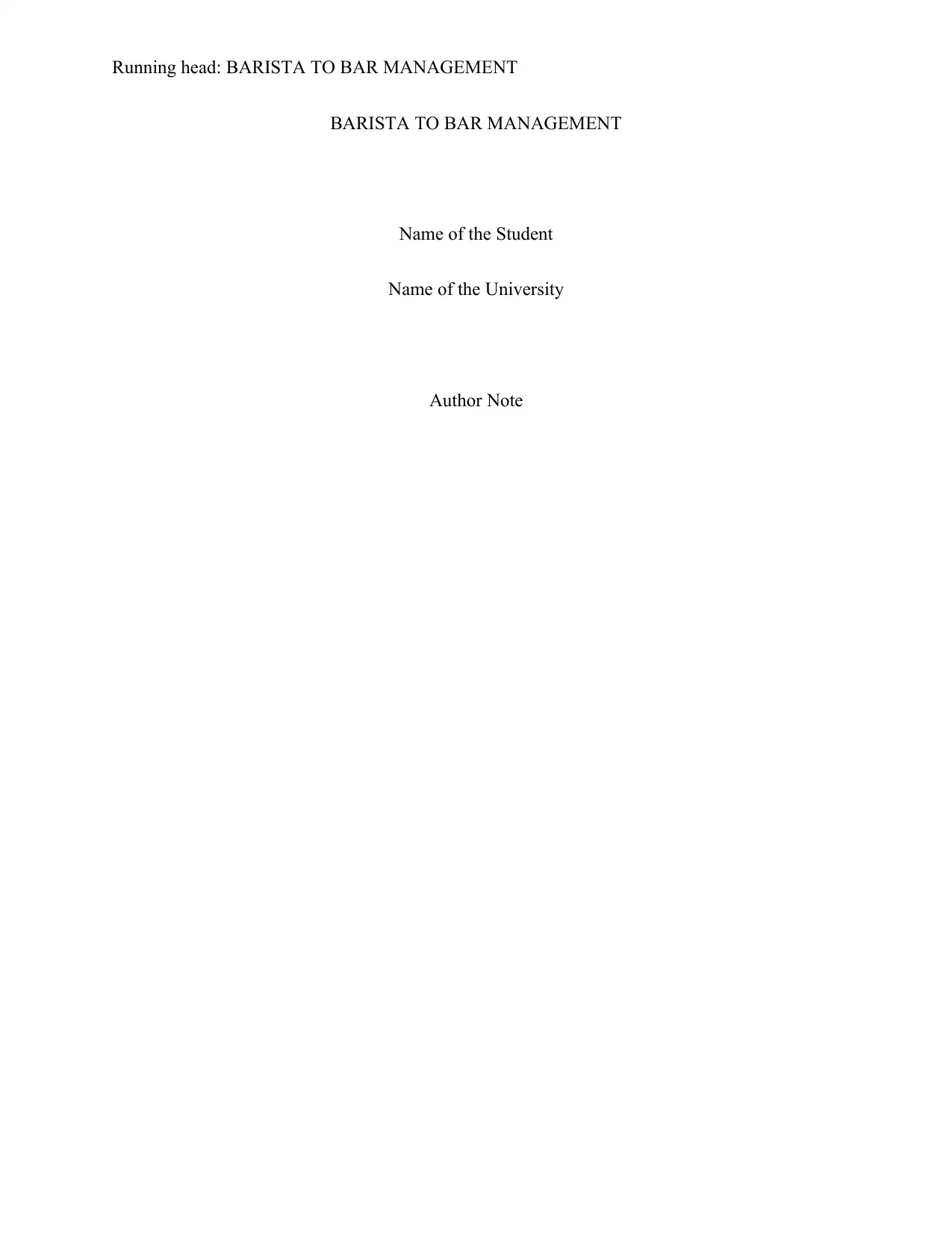
Running head: BARISTA TO BAR MANAGEMENT
BARISTA TO BAR MANAGEMENT
Name of the Student
Name of the University
Author Note
BARISTA TO BAR MANAGEMENT
Name of the Student
Name of the University
Author Note
Paraphrase This Document
Need a fresh take? Get an instant paraphrase of this document with our AI Paraphraser
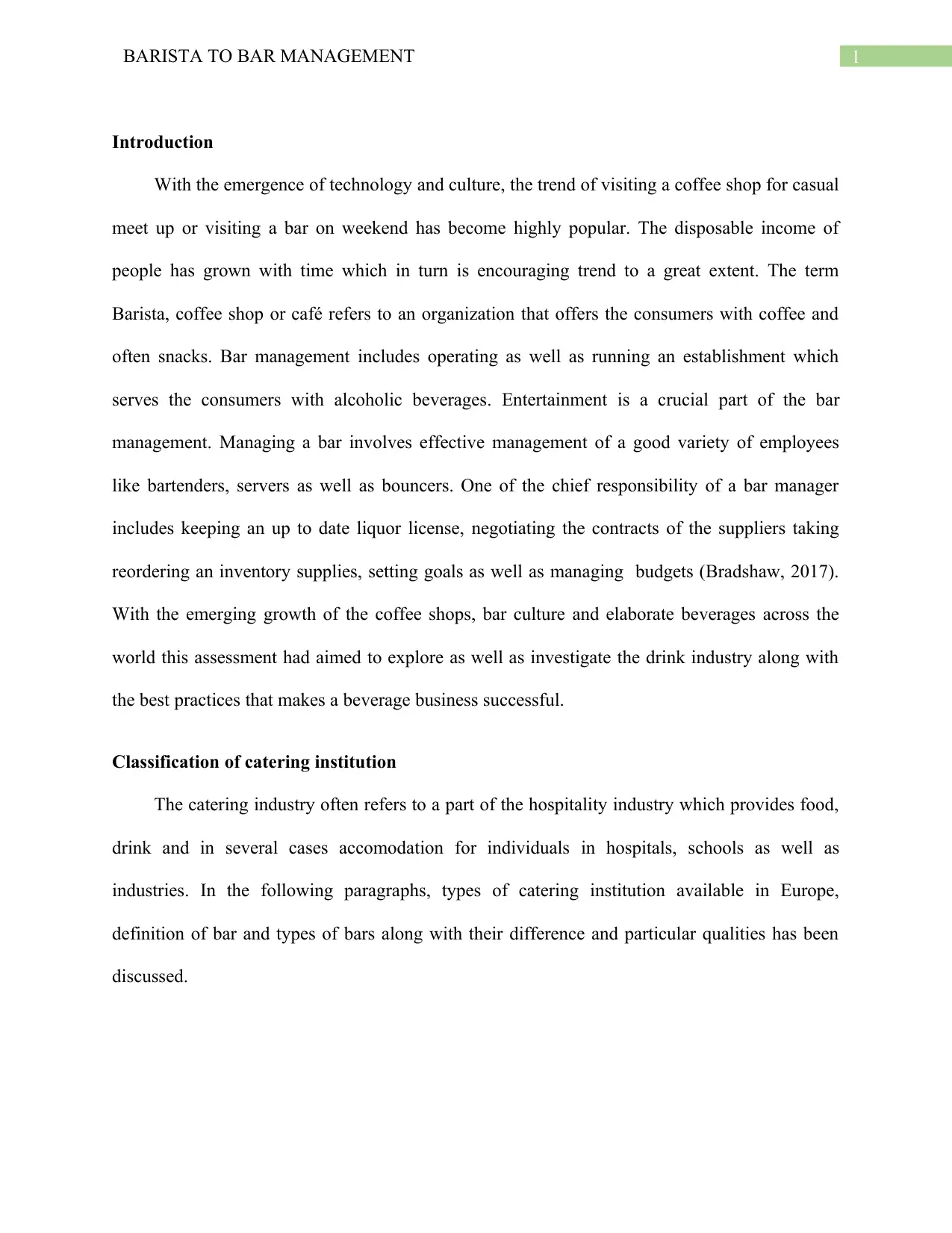
1BARISTA TO BAR MANAGEMENT
Introduction
With the emergence of technology and culture, the trend of visiting a coffee shop for casual
meet up or visiting a bar on weekend has become highly popular. The disposable income of
people has grown with time which in turn is encouraging trend to a great extent. The term
Barista, coffee shop or café refers to an organization that offers the consumers with coffee and
often snacks. Bar management includes operating as well as running an establishment which
serves the consumers with alcoholic beverages. Entertainment is a crucial part of the bar
management. Managing a bar involves effective management of a good variety of employees
like bartenders, servers as well as bouncers. One of the chief responsibility of a bar manager
includes keeping an up to date liquor license, negotiating the contracts of the suppliers taking
reordering an inventory supplies, setting goals as well as managing budgets (Bradshaw, 2017).
With the emerging growth of the coffee shops, bar culture and elaborate beverages across the
world this assessment had aimed to explore as well as investigate the drink industry along with
the best practices that makes a beverage business successful.
Classification of catering institution
The catering industry often refers to a part of the hospitality industry which provides food,
drink and in several cases accomodation for individuals in hospitals, schools as well as
industries. In the following paragraphs, types of catering institution available in Europe,
definition of bar and types of bars along with their difference and particular qualities has been
discussed.
Introduction
With the emergence of technology and culture, the trend of visiting a coffee shop for casual
meet up or visiting a bar on weekend has become highly popular. The disposable income of
people has grown with time which in turn is encouraging trend to a great extent. The term
Barista, coffee shop or café refers to an organization that offers the consumers with coffee and
often snacks. Bar management includes operating as well as running an establishment which
serves the consumers with alcoholic beverages. Entertainment is a crucial part of the bar
management. Managing a bar involves effective management of a good variety of employees
like bartenders, servers as well as bouncers. One of the chief responsibility of a bar manager
includes keeping an up to date liquor license, negotiating the contracts of the suppliers taking
reordering an inventory supplies, setting goals as well as managing budgets (Bradshaw, 2017).
With the emerging growth of the coffee shops, bar culture and elaborate beverages across the
world this assessment had aimed to explore as well as investigate the drink industry along with
the best practices that makes a beverage business successful.
Classification of catering institution
The catering industry often refers to a part of the hospitality industry which provides food,
drink and in several cases accomodation for individuals in hospitals, schools as well as
industries. In the following paragraphs, types of catering institution available in Europe,
definition of bar and types of bars along with their difference and particular qualities has been
discussed.

2BARISTA TO BAR MANAGEMENT
Types of catering institution
The catering institution can be segregated into two parts namely, primary or commercial catering
and secondary or noncommercial catering. Primary careering refers to the establishment whose
chief aim is to earn profit with the help of providing food as well as beverages to the consumers
as per their demands and thus are called commercial catering. Some major types of commercial
careering institutions includes hotels, restaurant, fast food outlet, pubs and bars. Commercial
catering can be further categorizes into residential and non-residential catering. While residential
catering institutions like hotels, motels and resorts provides food beverages and accommodations
to the consumers, non-residential catering institutions like bars, pubs, night clubs, coffee shops
and restaurants only provides foods and beverages to the same (Benin, Semenov & Ekaterina,
2016).
When it comes to the secondary or no commercial catering in, they includes
establishments that provide both food and beverages as a part of other businesses. Thus, unlike
the commercial catering institutions, their aim does not includes earning money. In contrast, they
aim to provide welfare services at affordable price range like industrial canteens, school or
college canteens, hospitals, airline catering, cruise lines and ships. Unlike the commercial
catering institutions, the consumers do not possess the choice of catering facilities. The chief
types of noncommercial catering includes institutional catering, transport catering, airline
catering, railway catering, ship catering, industrial catering and surface catering (Januš et al.,
2018). While institutional catering includes academic institutions, hospitals, orphanages, prisons,
and old age homes, transport catering includes providing food items and beverages to the
passengers, before and during their journey. In both the cases, he catering services are
completely or partially subsidized by a good number of government fund. Surface catering refer
Types of catering institution
The catering institution can be segregated into two parts namely, primary or commercial catering
and secondary or noncommercial catering. Primary careering refers to the establishment whose
chief aim is to earn profit with the help of providing food as well as beverages to the consumers
as per their demands and thus are called commercial catering. Some major types of commercial
careering institutions includes hotels, restaurant, fast food outlet, pubs and bars. Commercial
catering can be further categorizes into residential and non-residential catering. While residential
catering institutions like hotels, motels and resorts provides food beverages and accommodations
to the consumers, non-residential catering institutions like bars, pubs, night clubs, coffee shops
and restaurants only provides foods and beverages to the same (Benin, Semenov & Ekaterina,
2016).
When it comes to the secondary or no commercial catering in, they includes
establishments that provide both food and beverages as a part of other businesses. Thus, unlike
the commercial catering institutions, their aim does not includes earning money. In contrast, they
aim to provide welfare services at affordable price range like industrial canteens, school or
college canteens, hospitals, airline catering, cruise lines and ships. Unlike the commercial
catering institutions, the consumers do not possess the choice of catering facilities. The chief
types of noncommercial catering includes institutional catering, transport catering, airline
catering, railway catering, ship catering, industrial catering and surface catering (Januš et al.,
2018). While institutional catering includes academic institutions, hospitals, orphanages, prisons,
and old age homes, transport catering includes providing food items and beverages to the
passengers, before and during their journey. In both the cases, he catering services are
completely or partially subsidized by a good number of government fund. Surface catering refer
⊘ This is a preview!⊘
Do you want full access?
Subscribe today to unlock all pages.

Trusted by 1+ million students worldwide
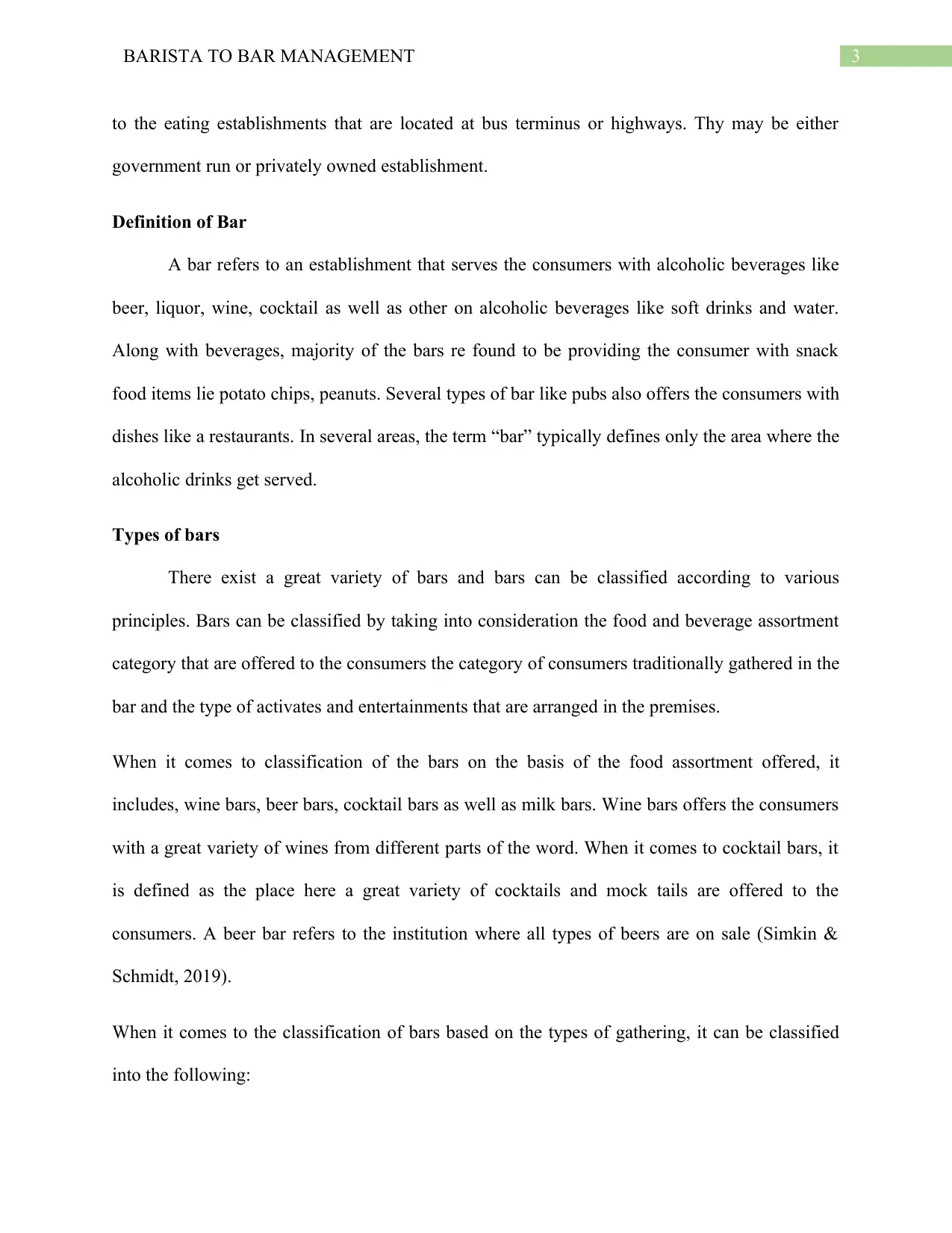
3BARISTA TO BAR MANAGEMENT
to the eating establishments that are located at bus terminus or highways. Thy may be either
government run or privately owned establishment.
Definition of Bar
A bar refers to an establishment that serves the consumers with alcoholic beverages like
beer, liquor, wine, cocktail as well as other on alcoholic beverages like soft drinks and water.
Along with beverages, majority of the bars re found to be providing the consumer with snack
food items lie potato chips, peanuts. Several types of bar like pubs also offers the consumers with
dishes like a restaurants. In several areas, the term “bar” typically defines only the area where the
alcoholic drinks get served.
Types of bars
There exist a great variety of bars and bars can be classified according to various
principles. Bars can be classified by taking into consideration the food and beverage assortment
category that are offered to the consumers the category of consumers traditionally gathered in the
bar and the type of activates and entertainments that are arranged in the premises.
When it comes to classification of the bars on the basis of the food assortment offered, it
includes, wine bars, beer bars, cocktail bars as well as milk bars. Wine bars offers the consumers
with a great variety of wines from different parts of the word. When it comes to cocktail bars, it
is defined as the place here a great variety of cocktails and mock tails are offered to the
consumers. A beer bar refers to the institution where all types of beers are on sale (Simkin &
Schmidt, 2019).
When it comes to the classification of bars based on the types of gathering, it can be classified
into the following:
to the eating establishments that are located at bus terminus or highways. Thy may be either
government run or privately owned establishment.
Definition of Bar
A bar refers to an establishment that serves the consumers with alcoholic beverages like
beer, liquor, wine, cocktail as well as other on alcoholic beverages like soft drinks and water.
Along with beverages, majority of the bars re found to be providing the consumer with snack
food items lie potato chips, peanuts. Several types of bar like pubs also offers the consumers with
dishes like a restaurants. In several areas, the term “bar” typically defines only the area where the
alcoholic drinks get served.
Types of bars
There exist a great variety of bars and bars can be classified according to various
principles. Bars can be classified by taking into consideration the food and beverage assortment
category that are offered to the consumers the category of consumers traditionally gathered in the
bar and the type of activates and entertainments that are arranged in the premises.
When it comes to classification of the bars on the basis of the food assortment offered, it
includes, wine bars, beer bars, cocktail bars as well as milk bars. Wine bars offers the consumers
with a great variety of wines from different parts of the word. When it comes to cocktail bars, it
is defined as the place here a great variety of cocktails and mock tails are offered to the
consumers. A beer bar refers to the institution where all types of beers are on sale (Simkin &
Schmidt, 2019).
When it comes to the classification of bars based on the types of gathering, it can be classified
into the following:
Paraphrase This Document
Need a fresh take? Get an instant paraphrase of this document with our AI Paraphraser
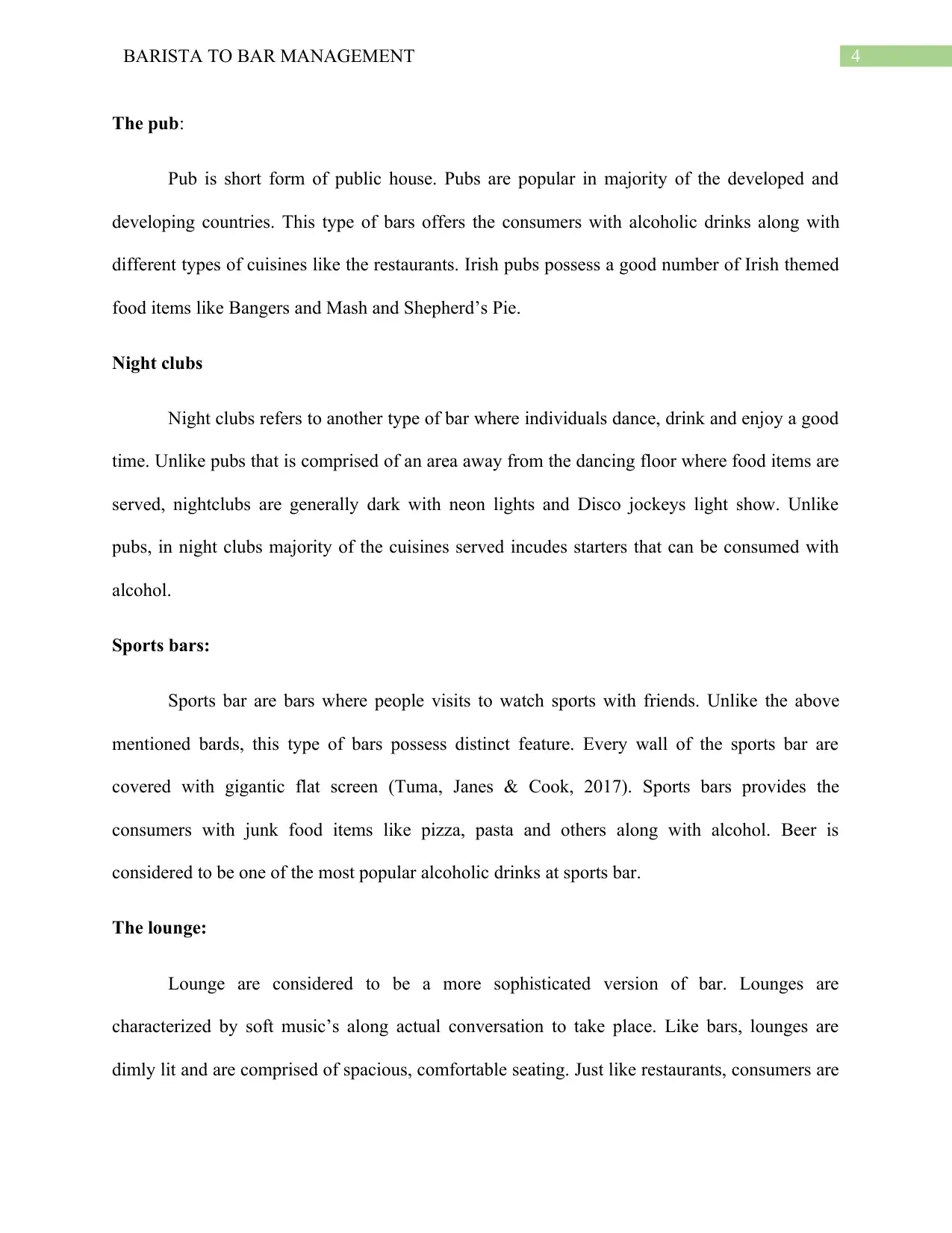
4BARISTA TO BAR MANAGEMENT
The pub:
Pub is short form of public house. Pubs are popular in majority of the developed and
developing countries. This type of bars offers the consumers with alcoholic drinks along with
different types of cuisines like the restaurants. Irish pubs possess a good number of Irish themed
food items like Bangers and Mash and Shepherd’s Pie.
Night clubs
Night clubs refers to another type of bar where individuals dance, drink and enjoy a good
time. Unlike pubs that is comprised of an area away from the dancing floor where food items are
served, nightclubs are generally dark with neon lights and Disco jockeys light show. Unlike
pubs, in night clubs majority of the cuisines served incudes starters that can be consumed with
alcohol.
Sports bars:
Sports bar are bars where people visits to watch sports with friends. Unlike the above
mentioned bards, this type of bars possess distinct feature. Every wall of the sports bar are
covered with gigantic flat screen (Tuma, Janes & Cook, 2017). Sports bars provides the
consumers with junk food items like pizza, pasta and others along with alcohol. Beer is
considered to be one of the most popular alcoholic drinks at sports bar.
The lounge:
Lounge are considered to be a more sophisticated version of bar. Lounges are
characterized by soft music’s along actual conversation to take place. Like bars, lounges are
dimly lit and are comprised of spacious, comfortable seating. Just like restaurants, consumers are
The pub:
Pub is short form of public house. Pubs are popular in majority of the developed and
developing countries. This type of bars offers the consumers with alcoholic drinks along with
different types of cuisines like the restaurants. Irish pubs possess a good number of Irish themed
food items like Bangers and Mash and Shepherd’s Pie.
Night clubs
Night clubs refers to another type of bar where individuals dance, drink and enjoy a good
time. Unlike pubs that is comprised of an area away from the dancing floor where food items are
served, nightclubs are generally dark with neon lights and Disco jockeys light show. Unlike
pubs, in night clubs majority of the cuisines served incudes starters that can be consumed with
alcohol.
Sports bars:
Sports bar are bars where people visits to watch sports with friends. Unlike the above
mentioned bards, this type of bars possess distinct feature. Every wall of the sports bar are
covered with gigantic flat screen (Tuma, Janes & Cook, 2017). Sports bars provides the
consumers with junk food items like pizza, pasta and others along with alcohol. Beer is
considered to be one of the most popular alcoholic drinks at sports bar.
The lounge:
Lounge are considered to be a more sophisticated version of bar. Lounges are
characterized by soft music’s along actual conversation to take place. Like bars, lounges are
dimly lit and are comprised of spacious, comfortable seating. Just like restaurants, consumers are
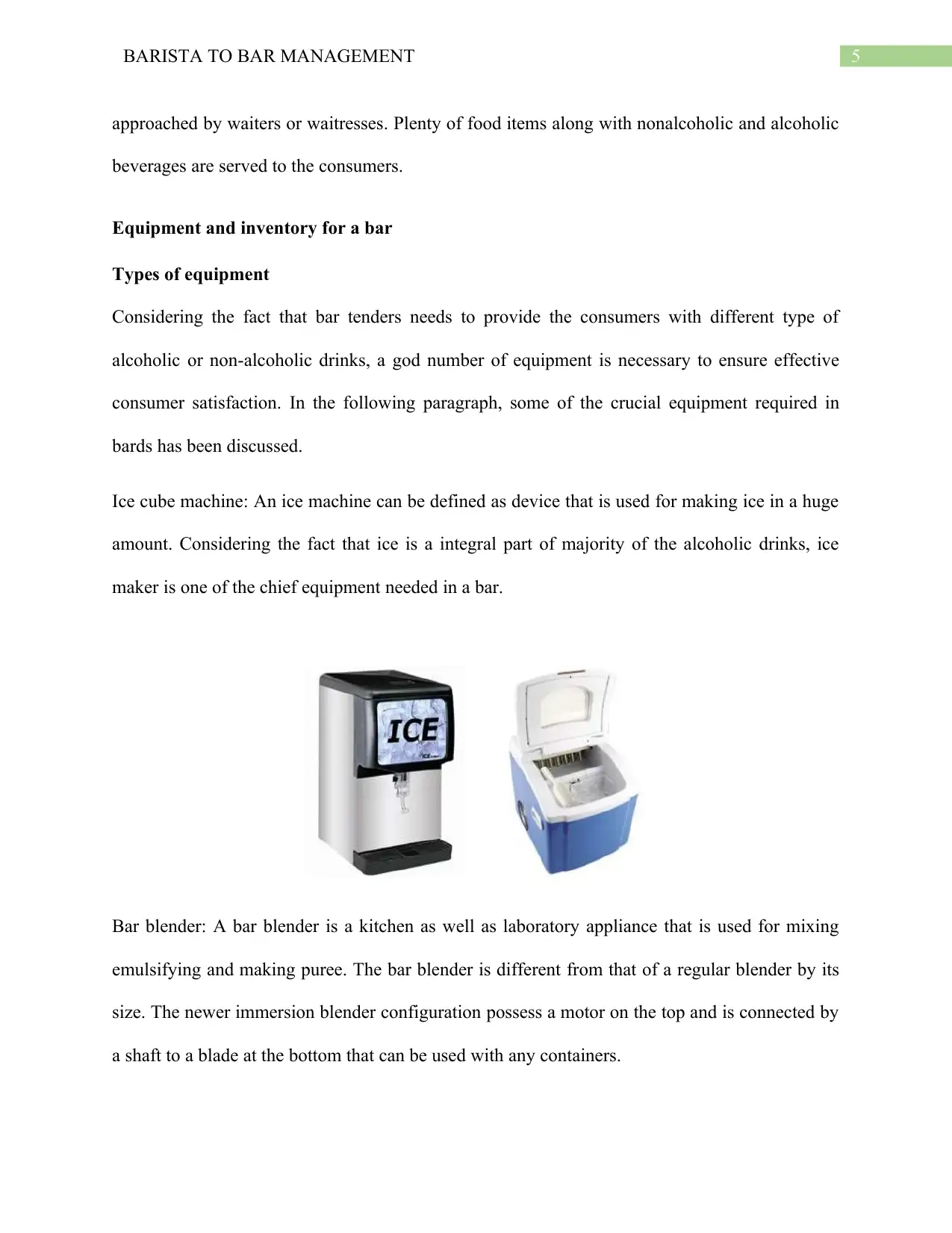
5BARISTA TO BAR MANAGEMENT
approached by waiters or waitresses. Plenty of food items along with nonalcoholic and alcoholic
beverages are served to the consumers.
Equipment and inventory for a bar
Types of equipment
Considering the fact that bar tenders needs to provide the consumers with different type of
alcoholic or non-alcoholic drinks, a god number of equipment is necessary to ensure effective
consumer satisfaction. In the following paragraph, some of the crucial equipment required in
bards has been discussed.
Ice cube machine: An ice machine can be defined as device that is used for making ice in a huge
amount. Considering the fact that ice is a integral part of majority of the alcoholic drinks, ice
maker is one of the chief equipment needed in a bar.
Bar blender: A bar blender is a kitchen as well as laboratory appliance that is used for mixing
emulsifying and making puree. The bar blender is different from that of a regular blender by its
size. The newer immersion blender configuration possess a motor on the top and is connected by
a shaft to a blade at the bottom that can be used with any containers.
approached by waiters or waitresses. Plenty of food items along with nonalcoholic and alcoholic
beverages are served to the consumers.
Equipment and inventory for a bar
Types of equipment
Considering the fact that bar tenders needs to provide the consumers with different type of
alcoholic or non-alcoholic drinks, a god number of equipment is necessary to ensure effective
consumer satisfaction. In the following paragraph, some of the crucial equipment required in
bards has been discussed.
Ice cube machine: An ice machine can be defined as device that is used for making ice in a huge
amount. Considering the fact that ice is a integral part of majority of the alcoholic drinks, ice
maker is one of the chief equipment needed in a bar.
Bar blender: A bar blender is a kitchen as well as laboratory appliance that is used for mixing
emulsifying and making puree. The bar blender is different from that of a regular blender by its
size. The newer immersion blender configuration possess a motor on the top and is connected by
a shaft to a blade at the bottom that can be used with any containers.
⊘ This is a preview!⊘
Do you want full access?
Subscribe today to unlock all pages.

Trusted by 1+ million students worldwide
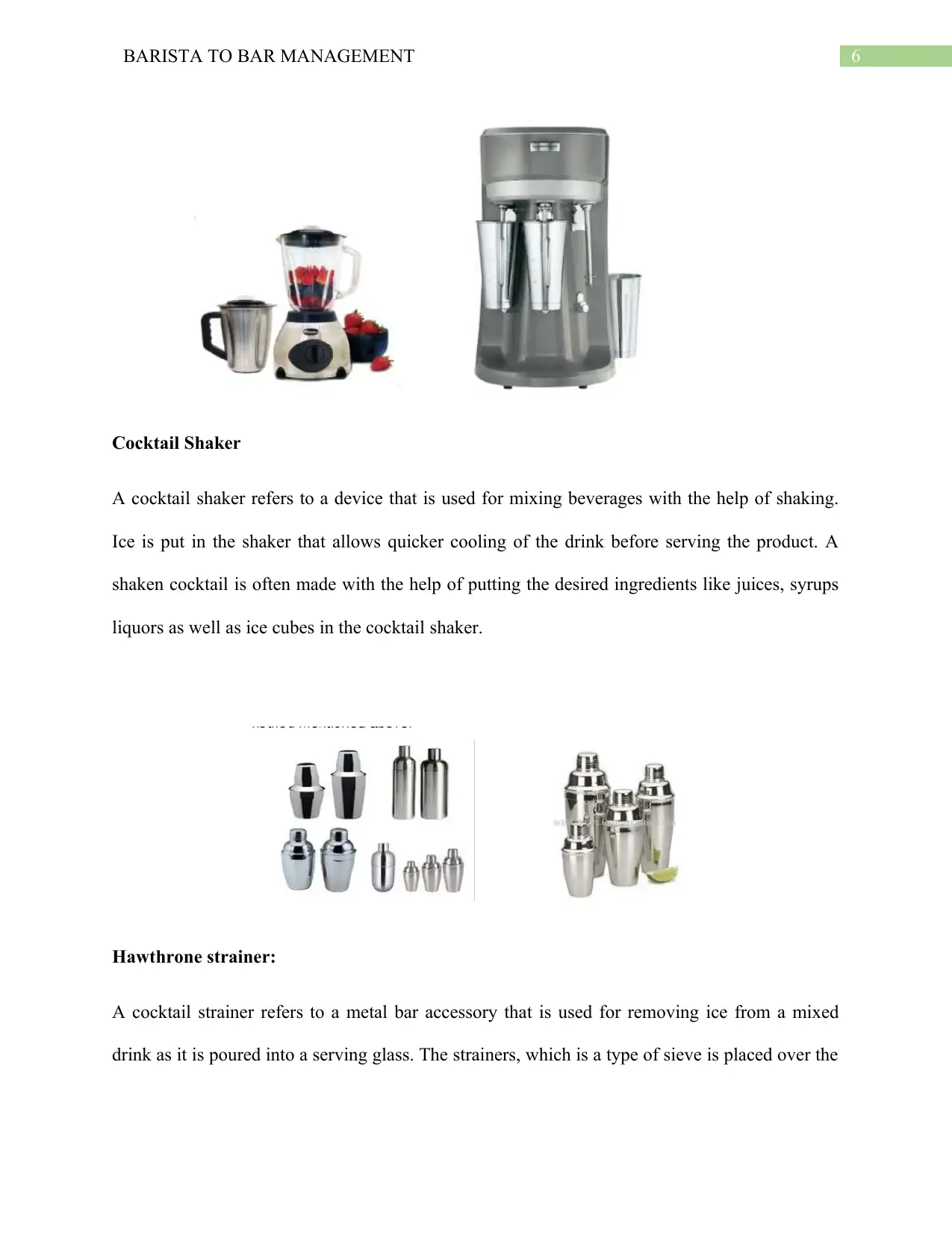
6BARISTA TO BAR MANAGEMENT
Cocktail Shaker
A cocktail shaker refers to a device that is used for mixing beverages with the help of shaking.
Ice is put in the shaker that allows quicker cooling of the drink before serving the product. A
shaken cocktail is often made with the help of putting the desired ingredients like juices, syrups
liquors as well as ice cubes in the cocktail shaker.
Hawthrone strainer:
A cocktail strainer refers to a metal bar accessory that is used for removing ice from a mixed
drink as it is poured into a serving glass. The strainers, which is a type of sieve is placed over the
Cocktail Shaker
A cocktail shaker refers to a device that is used for mixing beverages with the help of shaking.
Ice is put in the shaker that allows quicker cooling of the drink before serving the product. A
shaken cocktail is often made with the help of putting the desired ingredients like juices, syrups
liquors as well as ice cubes in the cocktail shaker.
Hawthrone strainer:
A cocktail strainer refers to a metal bar accessory that is used for removing ice from a mixed
drink as it is poured into a serving glass. The strainers, which is a type of sieve is placed over the
Paraphrase This Document
Need a fresh take? Get an instant paraphrase of this document with our AI Paraphraser
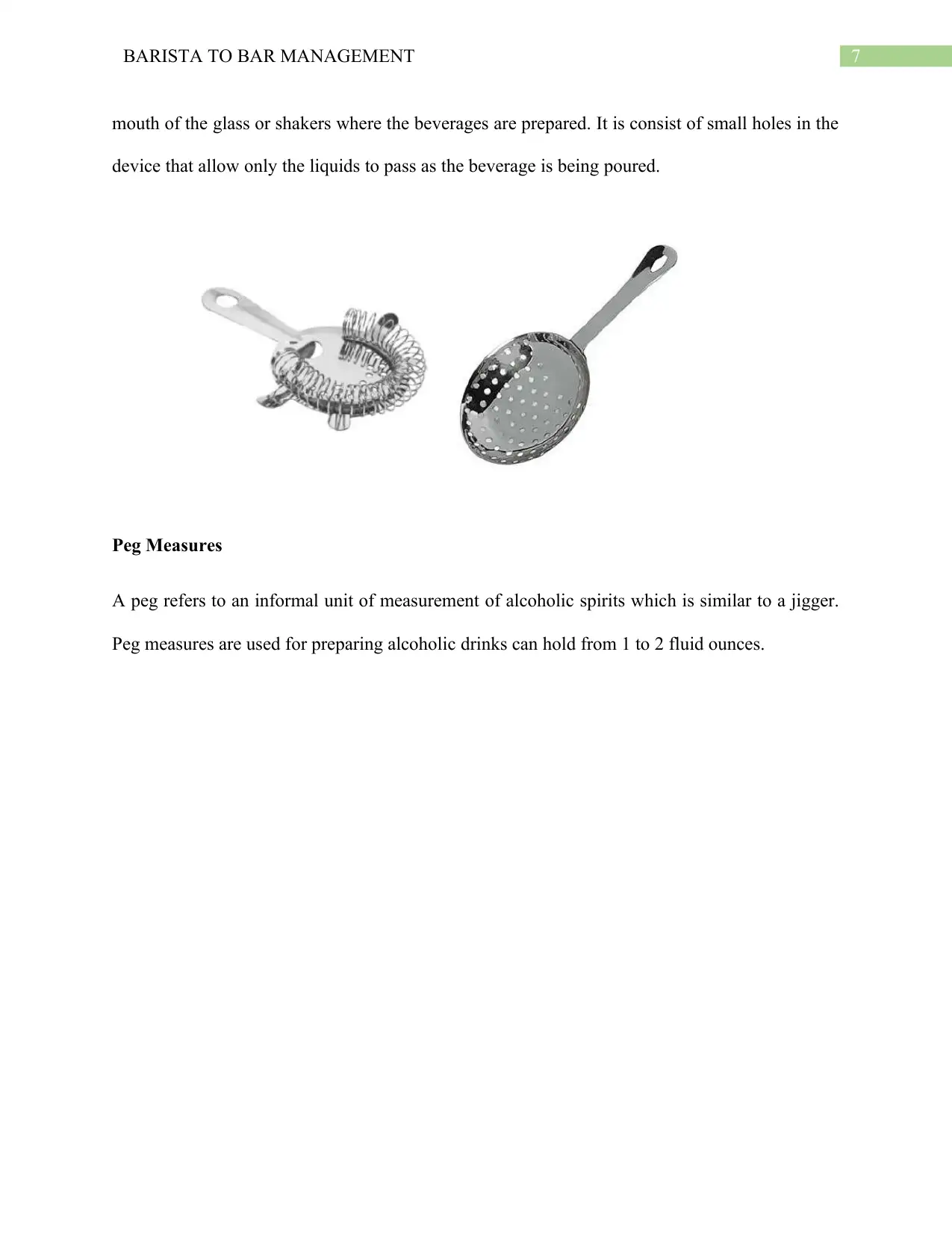
7BARISTA TO BAR MANAGEMENT
mouth of the glass or shakers where the beverages are prepared. It is consist of small holes in the
device that allow only the liquids to pass as the beverage is being poured.
Peg Measures
A peg refers to an informal unit of measurement of alcoholic spirits which is similar to a jigger.
Peg measures are used for preparing alcoholic drinks can hold from 1 to 2 fluid ounces.
mouth of the glass or shakers where the beverages are prepared. It is consist of small holes in the
device that allow only the liquids to pass as the beverage is being poured.
Peg Measures
A peg refers to an informal unit of measurement of alcoholic spirits which is similar to a jigger.
Peg measures are used for preparing alcoholic drinks can hold from 1 to 2 fluid ounces.

8BARISTA TO BAR MANAGEMENT
Types of inventory
The inventory in a bar involves the whole list of liquor as well as other stoked products that are
served to the consumers. Thus a beer inventory chiefly is comprised of beer, soda juices, wine as
well as other beverages that are listed in the menu.
When it comes to the types of inventory, the first can be the status quo. Majority of the bars are
found to be opting for status quo. At the end of the month, this type of inventory helps the
mentioned organization to calculate and value it. At the end of the months, the managers used to
count their inventory (Jonatova et al., 2020).
When it comes to manual inventory control, it includes counting the inventory on a
regular basis for reconcile each and every items along with recognizing any kind of
Types of inventory
The inventory in a bar involves the whole list of liquor as well as other stoked products that are
served to the consumers. Thus a beer inventory chiefly is comprised of beer, soda juices, wine as
well as other beverages that are listed in the menu.
When it comes to the types of inventory, the first can be the status quo. Majority of the bars are
found to be opting for status quo. At the end of the month, this type of inventory helps the
mentioned organization to calculate and value it. At the end of the months, the managers used to
count their inventory (Jonatova et al., 2020).
When it comes to manual inventory control, it includes counting the inventory on a
regular basis for reconcile each and every items along with recognizing any kind of
⊘ This is a preview!⊘
Do you want full access?
Subscribe today to unlock all pages.

Trusted by 1+ million students worldwide

9BARISTA TO BAR MANAGEMENT
discrepancies. For this method, spreadsheet as well as worksheets are needed for taking the
inventory counts. The three chief that the management needs to input the total of all the alcohol
categories in a bar includes starting inventory, received inventory and the ending inventory.
Drinks and Alcohol
Types of coffee beans
Cofee is considered to be one of the most popular non alcoholic beverages in Europe. The
three chief types of coffee beans that are used by the Cafeterias in the nation includes Coffea
Arabica, Robusta and Coffea Liberica. According to researchers, Coffea Arabica makes up to 70
percent of the international coffee bean market. Being of higher taste and value, this type of
coffee beans are sold in expensive coffee shops. The hand picking ensure a higher quality of
selection with lower chance of under ripe or over ripe beans. When it comes to coffee
Canephora or Robasta it is defined as a high caffeine content species that makes up to 27 percent
of the international coffee market. It is cheaper than Coffea Arabica (Wong et al., 2018). Caffea
Libreca makes upto 3 percent of the world’s coffee market and is commonly known as Libreian
Coffee.
Types of coffee drinks
With the increment in the cafe culture, not only I Europe but in other parts of the word,
café owners are trying to incorporate different types of coffee to be offered to the consumers, in
order to ensure enhanced competitive advantages. In the following paragraph, some of the most
popular types of coffee beans has been discussed.
Cafe Latte: it is a highly popular coffee drink in Europe and is consists of steamed or scalded
milk with a single shot of coffee. It is usually frothy.
discrepancies. For this method, spreadsheet as well as worksheets are needed for taking the
inventory counts. The three chief that the management needs to input the total of all the alcohol
categories in a bar includes starting inventory, received inventory and the ending inventory.
Drinks and Alcohol
Types of coffee beans
Cofee is considered to be one of the most popular non alcoholic beverages in Europe. The
three chief types of coffee beans that are used by the Cafeterias in the nation includes Coffea
Arabica, Robusta and Coffea Liberica. According to researchers, Coffea Arabica makes up to 70
percent of the international coffee bean market. Being of higher taste and value, this type of
coffee beans are sold in expensive coffee shops. The hand picking ensure a higher quality of
selection with lower chance of under ripe or over ripe beans. When it comes to coffee
Canephora or Robasta it is defined as a high caffeine content species that makes up to 27 percent
of the international coffee market. It is cheaper than Coffea Arabica (Wong et al., 2018). Caffea
Libreca makes upto 3 percent of the world’s coffee market and is commonly known as Libreian
Coffee.
Types of coffee drinks
With the increment in the cafe culture, not only I Europe but in other parts of the word,
café owners are trying to incorporate different types of coffee to be offered to the consumers, in
order to ensure enhanced competitive advantages. In the following paragraph, some of the most
popular types of coffee beans has been discussed.
Cafe Latte: it is a highly popular coffee drink in Europe and is consists of steamed or scalded
milk with a single shot of coffee. It is usually frothy.
Paraphrase This Document
Need a fresh take? Get an instant paraphrase of this document with our AI Paraphraser
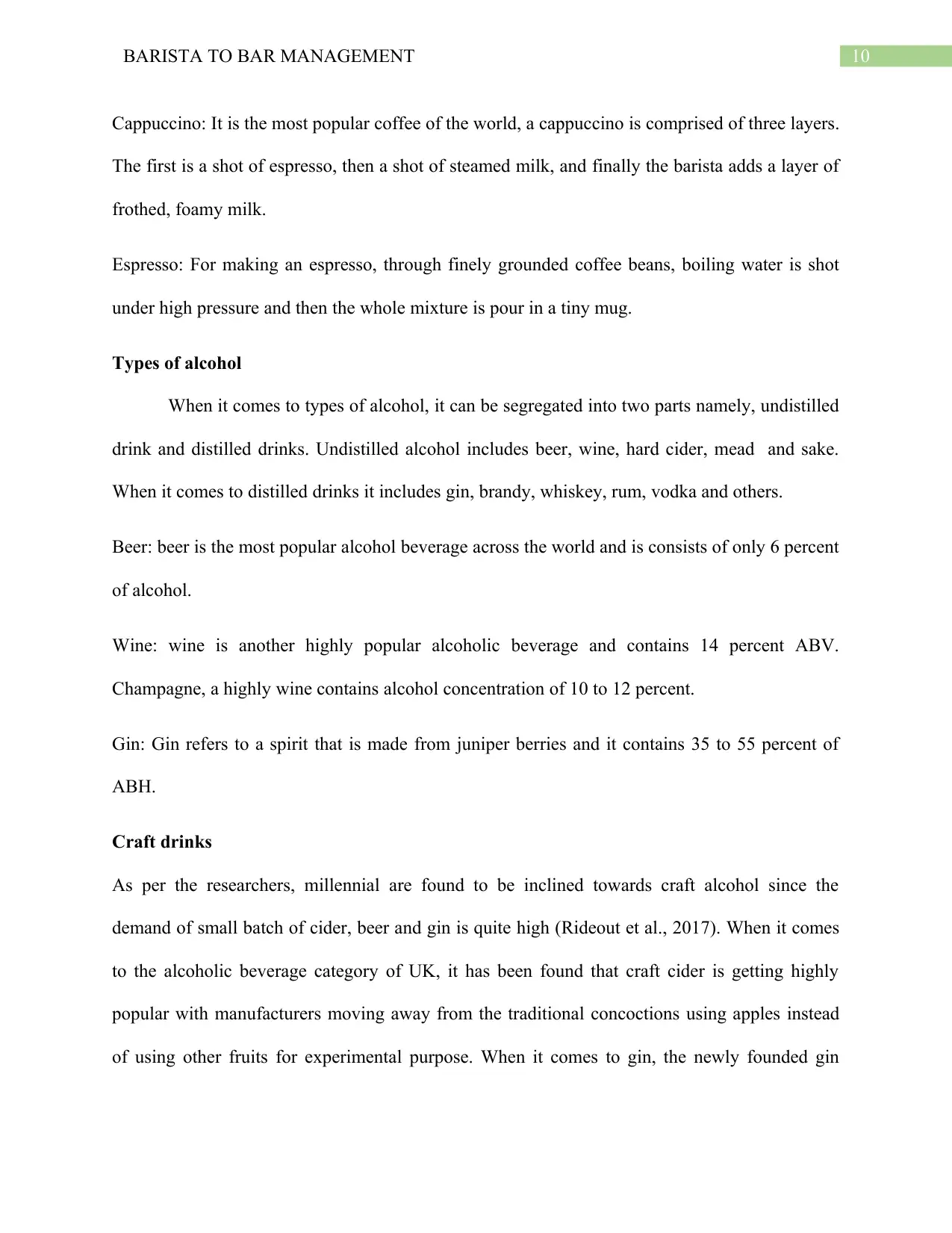
10BARISTA TO BAR MANAGEMENT
Cappuccino: It is the most popular coffee of the world, a cappuccino is comprised of three layers.
The first is a shot of espresso, then a shot of steamed milk, and finally the barista adds a layer of
frothed, foamy milk.
Espresso: For making an espresso, through finely grounded coffee beans, boiling water is shot
under high pressure and then the whole mixture is pour in a tiny mug.
Types of alcohol
When it comes to types of alcohol, it can be segregated into two parts namely, undistilled
drink and distilled drinks. Undistilled alcohol includes beer, wine, hard cider, mead and sake.
When it comes to distilled drinks it includes gin, brandy, whiskey, rum, vodka and others.
Beer: beer is the most popular alcohol beverage across the world and is consists of only 6 percent
of alcohol.
Wine: wine is another highly popular alcoholic beverage and contains 14 percent ABV.
Champagne, a highly wine contains alcohol concentration of 10 to 12 percent.
Gin: Gin refers to a spirit that is made from juniper berries and it contains 35 to 55 percent of
ABH.
Craft drinks
As per the researchers, millennial are found to be inclined towards craft alcohol since the
demand of small batch of cider, beer and gin is quite high (Rideout et al., 2017). When it comes
to the alcoholic beverage category of UK, it has been found that craft cider is getting highly
popular with manufacturers moving away from the traditional concoctions using apples instead
of using other fruits for experimental purpose. When it comes to gin, the newly founded gin
Cappuccino: It is the most popular coffee of the world, a cappuccino is comprised of three layers.
The first is a shot of espresso, then a shot of steamed milk, and finally the barista adds a layer of
frothed, foamy milk.
Espresso: For making an espresso, through finely grounded coffee beans, boiling water is shot
under high pressure and then the whole mixture is pour in a tiny mug.
Types of alcohol
When it comes to types of alcohol, it can be segregated into two parts namely, undistilled
drink and distilled drinks. Undistilled alcohol includes beer, wine, hard cider, mead and sake.
When it comes to distilled drinks it includes gin, brandy, whiskey, rum, vodka and others.
Beer: beer is the most popular alcohol beverage across the world and is consists of only 6 percent
of alcohol.
Wine: wine is another highly popular alcoholic beverage and contains 14 percent ABV.
Champagne, a highly wine contains alcohol concentration of 10 to 12 percent.
Gin: Gin refers to a spirit that is made from juniper berries and it contains 35 to 55 percent of
ABH.
Craft drinks
As per the researchers, millennial are found to be inclined towards craft alcohol since the
demand of small batch of cider, beer and gin is quite high (Rideout et al., 2017). When it comes
to the alcoholic beverage category of UK, it has been found that craft cider is getting highly
popular with manufacturers moving away from the traditional concoctions using apples instead
of using other fruits for experimental purpose. When it comes to gin, the newly founded gin
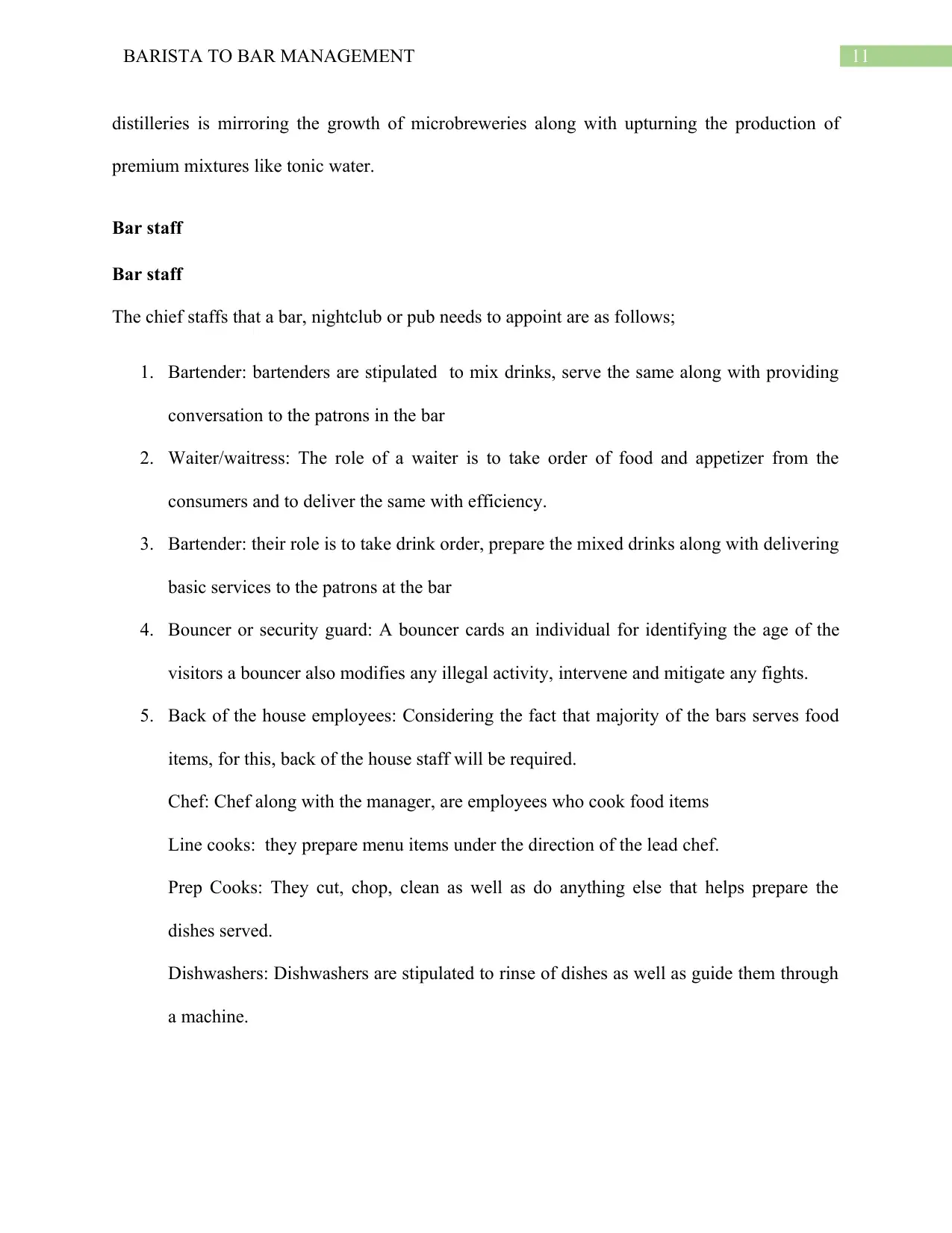
11BARISTA TO BAR MANAGEMENT
distilleries is mirroring the growth of microbreweries along with upturning the production of
premium mixtures like tonic water.
Bar staff
Bar staff
The chief staffs that a bar, nightclub or pub needs to appoint are as follows;
1. Bartender: bartenders are stipulated to mix drinks, serve the same along with providing
conversation to the patrons in the bar
2. Waiter/waitress: The role of a waiter is to take order of food and appetizer from the
consumers and to deliver the same with efficiency.
3. Bartender: their role is to take drink order, prepare the mixed drinks along with delivering
basic services to the patrons at the bar
4. Bouncer or security guard: A bouncer cards an individual for identifying the age of the
visitors a bouncer also modifies any illegal activity, intervene and mitigate any fights.
5. Back of the house employees: Considering the fact that majority of the bars serves food
items, for this, back of the house staff will be required.
Chef: Chef along with the manager, are employees who cook food items
Line cooks: they prepare menu items under the direction of the lead chef.
Prep Cooks: They cut, chop, clean as well as do anything else that helps prepare the
dishes served.
Dishwashers: Dishwashers are stipulated to rinse of dishes as well as guide them through
a machine.
distilleries is mirroring the growth of microbreweries along with upturning the production of
premium mixtures like tonic water.
Bar staff
Bar staff
The chief staffs that a bar, nightclub or pub needs to appoint are as follows;
1. Bartender: bartenders are stipulated to mix drinks, serve the same along with providing
conversation to the patrons in the bar
2. Waiter/waitress: The role of a waiter is to take order of food and appetizer from the
consumers and to deliver the same with efficiency.
3. Bartender: their role is to take drink order, prepare the mixed drinks along with delivering
basic services to the patrons at the bar
4. Bouncer or security guard: A bouncer cards an individual for identifying the age of the
visitors a bouncer also modifies any illegal activity, intervene and mitigate any fights.
5. Back of the house employees: Considering the fact that majority of the bars serves food
items, for this, back of the house staff will be required.
Chef: Chef along with the manager, are employees who cook food items
Line cooks: they prepare menu items under the direction of the lead chef.
Prep Cooks: They cut, chop, clean as well as do anything else that helps prepare the
dishes served.
Dishwashers: Dishwashers are stipulated to rinse of dishes as well as guide them through
a machine.
⊘ This is a preview!⊘
Do you want full access?
Subscribe today to unlock all pages.

Trusted by 1+ million students worldwide
1 out of 16
Related Documents
Your All-in-One AI-Powered Toolkit for Academic Success.
+13062052269
info@desklib.com
Available 24*7 on WhatsApp / Email
![[object Object]](/_next/static/media/star-bottom.7253800d.svg)
Unlock your academic potential
Copyright © 2020–2025 A2Z Services. All Rights Reserved. Developed and managed by ZUCOL.


